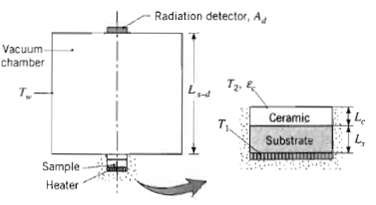One scheme for extending the operation of gas turbine blades to higher temperatures involves applying a ceramic
Question:
One scheme for extending the operation of gas turbine blades to higher temperatures involves applying a ceramic coating to the surfaces of blades fabricated from a super alloy such as inconel. To assess the reliability of such coatings, an apparatus has been developed for testing samples under laboratory conditions. The sample is placed at the bottom of a large vacuum chamber whose walls are cryogenically cooled and which is equipped with a radiation detector at the top surface. The detector has a surface area of Ad = 10???5 m2, is located at a distance of Ls-d = 1 m from the sample, and views radiation originating from a portion of the ceramic surface having an area of ?Ac = 10???4 m2. An electric heater attached to the bottom of the sample dissipates a uniform heat flux, g''h, which is transferred upward through the sample. The bottom of the heater and sides of the sample are well insulated. Consider conditions for which a ceramic coating of thickness Lc = 0.5 mm and thermal conductivity kc = 6 W/m ? K has been sprayed on a metal substrate of thickness Ls = 8 mm and thermal conductivity ks = 25 W/m ? K. The opaque surface of the ceramic may be approximated as diffuse and gray, with a total, hemispherical emissivity of ?c = 0.8.
(a) Consider steady-state conditions for which the bottom surface of the substrate is maintained at T1 = 1500 K, while the chamber walls (including the surface of the radiation detector) are maintained at Tw = 90 K. Assuming negligible thermal contact resistance at the ceramic-substrate interface, determine the ceramic top surface temperature T2 and the heat flux q''h.
(b) For the prescribed conditions, what is the rate at which radiation emitted by the ceramic is intercepted by the detector?
(c) After repeated experiments, numerous cracks develop at the ceramic-substrate interface, creating an interfacial thermal contact resistance. If Tw and q;; are maintained at the conditions associated with part (a), will TI increase, decrease, or remain the same? Similarly, will T2 increase, decrease, or remain the same? In each case, justify your answer.

Step by Step Answer:

Fundamentals of Heat and Mass Transfer
ISBN: 978-0471457282
6th Edition
Authors: Incropera, Dewitt, Bergman, Lavine





